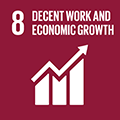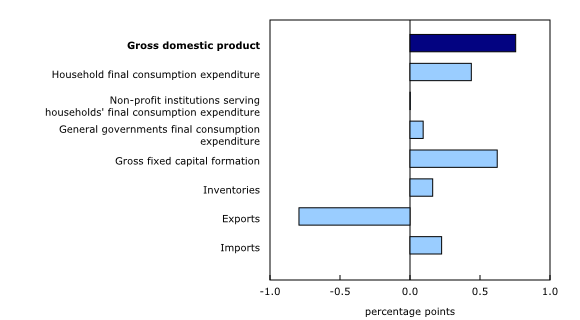Gross domestic product, income and expenditure, first quarter 2022
Archived Content
Information identified as archived is provided for reference, research or recordkeeping purposes. It is not subject to the Government of Canada Web Standards and has not been altered or updated since it was archived. Please "contact us" to request a format other than those available.
Released: 2022-05-31
Real gross domestic product (GDP) grew 0.8% in the first quarter of 2022, a third consecutive quarterly increase, mainly on the strength of increased business investment and household consumption. Growth slowed in the first quarter compared with the previous two quarters due to a drop in international exports volumes. Final domestic demand rose by 1.2%, following a 0.9% increase in the fourth quarter of 2021.
Export volumes declined 2.4% in the first quarter, following two consecutive quarterly increases. Decreased international trade of energy products contributed to overall declines in both exports (-2.4%) and imports (-0.7%).
Residential investment and mortgages continue to rise
Investment in residential construction rose for a second consecutive quarter, up 4.3%, as renovations (+9.3%), resale costs (+4.6%) and new construction (+0.2%) all increased in the first quarter of 2022. Aside from Alberta and the territories, new construction increased in every province, led by the Atlantic provinces. Home resale activity was particularly robust in Alberta (+27.4%) and Prince Edward Island (+15.0%).
While new construction and notable renovation activity pushed the value of residential structures to $3.5 trillion, Canadians added $33.9 billion in household residential mortgage debt in the first quarter of 2022, down from the $44.8 billion recorded in the fourth quarter of 2021. The Bank of Canada raised the policy interest rate in the first quarter to 0.5% from 0.25%, where it had remained since the first quarter of 2020.
Business investment in non-residential structures (+2.9%) and in machinery and equipment (+0.9%) also increased in the first quarter of 2022. Investment in engineering structures rose 3.5%, as spending on the Kitimat LNG project in British Columbia and oil and gas activity increased.
Higher household spending spurs growth
Household spending rose 0.8% in the first quarter, a third consecutive quarterly increase, as outlays on most goods and services expanded, even with limited capacity restrictions throughout Canada on in-person shopping and services.
Outlays for durable goods increased 2.6% in the first quarter, following a 0.3% increase in the fourth quarter of 2021. Aside from the third quarter of 2020, this was the largest quarterly increase of durable goods outlays in five years. Higher outlays on new passenger cars (+16.1%) and new trucks, vans and sport utility vehicles (+3.5%) led the growth. Despite the increases, spending on automobiles remained lower than pre-pandemic levels, as lagging supply chain issues continue to impact the auto industry.
Outlays for services rose 0.7% in the first quarter, a seventh consecutive quarterly increase. Even with consecutive increases, outlays on services remained lower than the pre-pandemic high, set in the fourth quarter of 2019.
Gross domestic product implicit price index continues to rise, as terms-of-trade improve
The GDP implicit price index, which reflects the overall price of domestically produced goods and services, increased 2.9% in the first quarter, primarily due to higher export prices of crude oil and bitumen (+23.0%). Household consumption prices for fuels and lubricants (+10.4%) and prices of housing investment (+3.9%) also contributed to a higher GDP implicit price in the first quarter. Household consumption prices were up by a significant amount in the quarter and have risen by 4.8% since the first quarter of 2021. By comparison, the Consumer Price Index also saw significant increases in the first quarter of 2022.
The terms-of-trade (ratio of price of exports to price of imports) reached 109.7 for the first quarter, as the index grew 4.2%. Strengthening export prices (+7.1%) were again heavily influenced by the rising price of crude oil. Significant increases in the prices of other exports, such as lumber (+25.0%), electricity (+24.8%) and refined petroleum products (+21.2%), reflecting continued price pressures due to supply constraints, also impacted the terms-of-trade in the first quarter.
Comparatively, the total imports deflator increased 2.7%, a fourth consecutive quarterly increase. Although higher prices were seen in imports, such as pharmaceuticals and medicinal products (+7.8%) and refined petroleum energy products (+8.4%), these boosts were not enough to offset the higher export prices.
Significant growth in compensation of employees
Growth in nominal GDP (+3.7%) in the first quarter was led by higher compensation of employees.
Compensation of employees rose 3.8% on a nominal basis, following a 2.0% increase in the fourth quarter of 2021. Excluding the third quarter of 2020, this was the largest quarterly growth in compensation of employees since the second quarter of 1981.
Increases in compensation of employees were due mainly to average wages, which almost double the rate of growth for employment. Average wages rose along with increased economic activity and employers' efforts to attract qualified workers by offering higher salaries. Significant wage growth was recorded throughout the economy, including in professional and personal services, trade, manufacturing, health care and social assistance and construction industries.
Gains in employee compensation occurred across most parts of the country, with growth for the first quarter strongest in Quebec (+4.5%; representing one-quarter of the increase for Canada), British Columbia (+4.2%; representing 15% of the increase for Canada), and Ontario (+3.9%; representing 42% of the increase for Canada).
Household savings rate climbs on higher disposable income
Within the household sector (nominal terms at quarterly rates), compensation of employees increased by $12.4 billion in the first quarter, while mixed incomes and property incomes (i.e., interest and dividends) were up a further $3.9 billion combined. Government transfers to households edged down 0.4% in the first quarter, accounting for 67.6% of all transfers received by households, the same share as the first quarter of 2020. By the end of 2021, the bulk of government measures to support households had ended. Households increased their payments to government for both personal income taxes and social insurance plan contributions, but this only slightly dampened the growth in disposable income, which increased $11.9 billion over the quarter.
Increases in nominal household disposable income, combined with a boost to employer-sponsored pension entitlements (+13.2%) outweighed higher household spending (+2.4%), which was bolstered by rising prices. This resulted in an 8.1% household savings rate in the first quarter of 2022. This rate followed a 6.9% household savings rate in the fourth quarter of 2021. By comparison, the average household savings rate over the decade prior to 2020 was 3.5%. The household savings rate is aggregated across all income brackets. In general, savings rates are greater in higher income brackets.
Household net saving remained elevated relative to pre-pandemic levels despite ongoing increases in the cost of living. Persistently high increases in the costs for such items as fuels and lubricants, as noted above, tend to filter through to household consumption prices for a range of goods and services. While these estimates indicate ongoing resiliency in household net saving up to the first quarter of 2022, these trends may not be sustainable over time if inflationary pressures on consumption persist, and if recent gains in employee compensation are not maintained.
Federal government support measures largely wound down
Several targeted federal government support programs continued in the first quarter, such as the Canadian Hiring Recovery Program, the Hardest-Hit Business Recovery Program (HHBRP), the Tourism and Hospitality Recovery Program (THRP), and the Canadian Worker Lockdown Benefit. However, other programs that supported both households and businesses were over by the end of 2021. Federal transfers to households continued to decline in the first quarter of 2022. The introduction of the THRP and HHBRP resulted in a small increase in federal subsidies, but levels remained well below those recorded in 2020 and 2021.
As part of the Canadian Emergency Business Account, borrowers were entitled to have a portion of their loan forgiven if they repaid the balance by the specified deadline. In the first quarter, these forgiven amounts were reflected as capital transfers from the federal government to corporations and households (i.e., unincorporated businesses).
Sustainable development goals
On January 1, 2016, the world officially began implementing the 2030 Agenda for Sustainable Development—the United Nations' transformative plan of action that addresses urgent global challenges over the following 15 years. The plan is based on 17 specific sustainable development goals.
Data on gross domestic product, income and expenditure are an example of how Statistics Canada supports the reporting on global sustainable development goals. This release will be used to measure the following goals:


Note to readers
Accounting for e-commerce transactions with non-resident vendors
Please note that the indicators used to estimate Household Final Consumption Expenditure have been adjusted to account for non-resident e-commerce sales. The Monthly Retail Trade Survey collects data on resident vendor e-commerce sales. This non-resident vendor e-commerce adjustment, which is applied to the indicators employed to estimate household consumption, mainly the Retail Commodity Survey, is a non-seasonally adjusted, quarterly value. This adjustment has been in place since the fourth quarter of 2019. For the first quarter, the adjustment represents $685.6 million applied to the household consumption indicators. The adjustment is derived using data sources such as detail customs transactions, GST remittances and financial statements for certain enterprises.
Updates to 2021 quarters
With this release, data have been updated from the first quarter of 2021 to the fourth quarter. These updates include new source data, such as an early version of the preliminary T4 data as well as Office of the Superintendent of Financial Institutions Insurance data. In addition, several source surveys have undergone historical and/or annual revisions, such as the Survey of Employment Payroll and Hours and the New Motor Vehicle Survey.
For information on the GDP revision cycle, see GDP revision cycle.
Support measures by governments
To alleviate the economic impact of the COVID-19 pandemic, governments implemented programs, such as the Canada Emergency Wage Subsidy, Canada Emergency Rent Subsidy and the Canada Recovery Benefit. A comprehensive explanation of how government support measures were treated in the compilation of the estimates is available in "Recording COVID-19 measures in the national accounts" and "Recording new COVID measures in the national accounts."
Details of some of the more significant federal government measures can be found on the page Federal government expenditures on COVID-19 response measures.
General
Percentage changes for expenditure-based statistics (such as household spending, investment, and exports) are calculated from volume measures that are adjusted for price variations. Percentage changes for income-based statistics (such as compensation of employees and operating surplus) are calculated from nominal values; that is, they are not adjusted for price variations.
Unless otherwise stated, growth rates represent the percentage change in the series from one quarter to the next; for instance, from the fourth quarter of 2021 to the first quarter of 2022.
For information on seasonal adjustment, see Seasonally adjusted data – Frequently asked questions.
Real-time tables
Real-time tables 36-10-0430-01 and 36-10-0431-01 will be updated on June 6, 2022.
Next release
Data on GDP by income and expenditure for the second quarter of 2022 will be released on August 31, 2022.
Products
The data visualization product "Gross Domestic Product by Income and Expenditure: Interactive tool," which is part of the Statistics Canada – Data Visualization Products series (71-607-X), is now available.
The document, "Recording new COVID measures in the national accounts," which is part of Latest Developments in the Canadian Economic Accounts (13-605-X), is available.
The Economic accounts statistics portal, accessible from the Subjects module of the Statistics Canada website, features an up-to-date portrait of national and provincial economies and their structure.
The User Guide: Canadian System of Macroeconomic Accounts (13-606-G) is available.
The Methodological Guide: Canadian System of Macroeconomic Accounts (13-607-X) is available.
Contact information
For more information, or to enquire about the concepts, methods or data quality of this release, contact us (toll-free 1-800-263-1136; 514-283-8300; STATCAN.infostats-infostats.STATCAN@statcan.gc.ca) or Media Relations (STATCAN.mediahotline-ligneinfomedias.STATCAN@statcan.gc.ca).
- Date modified:






